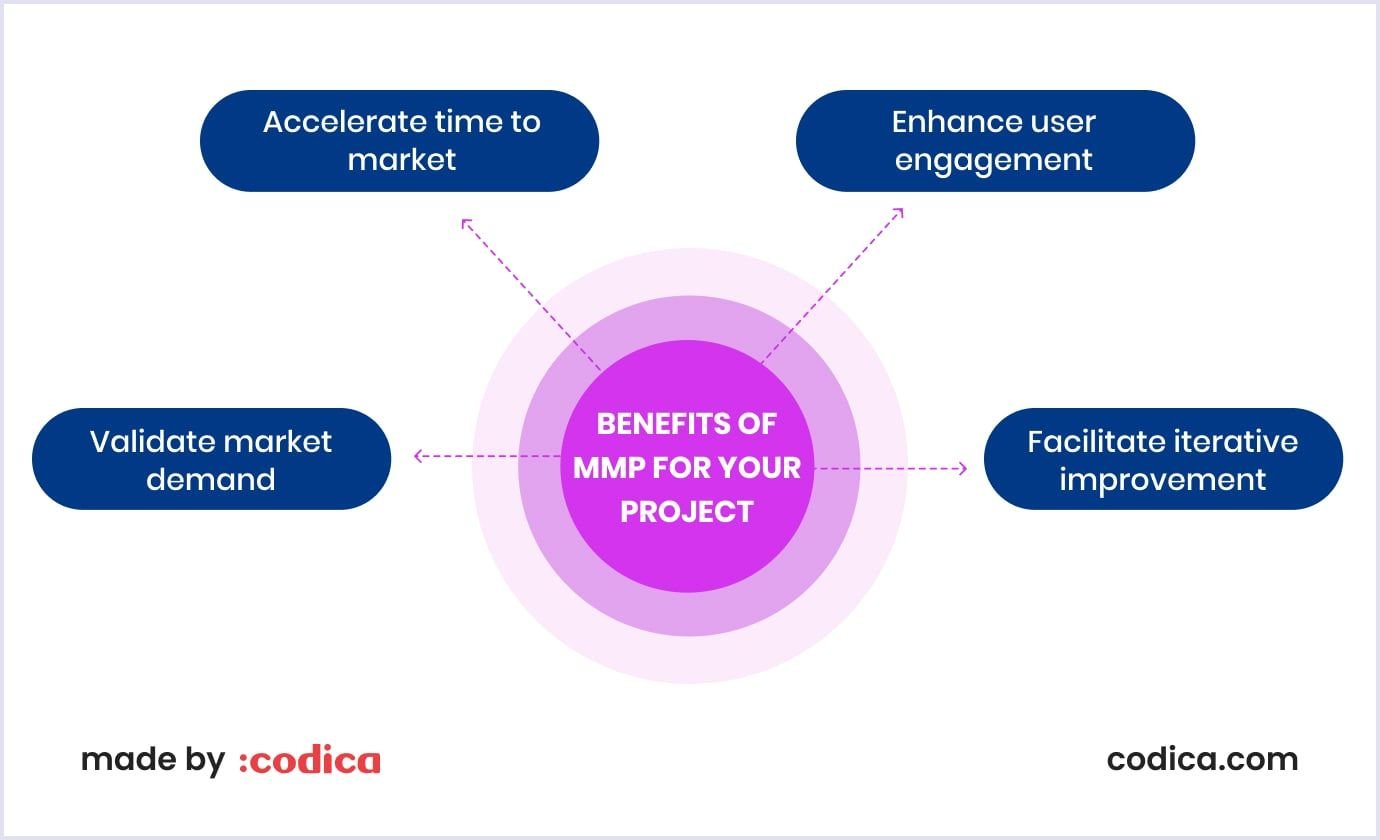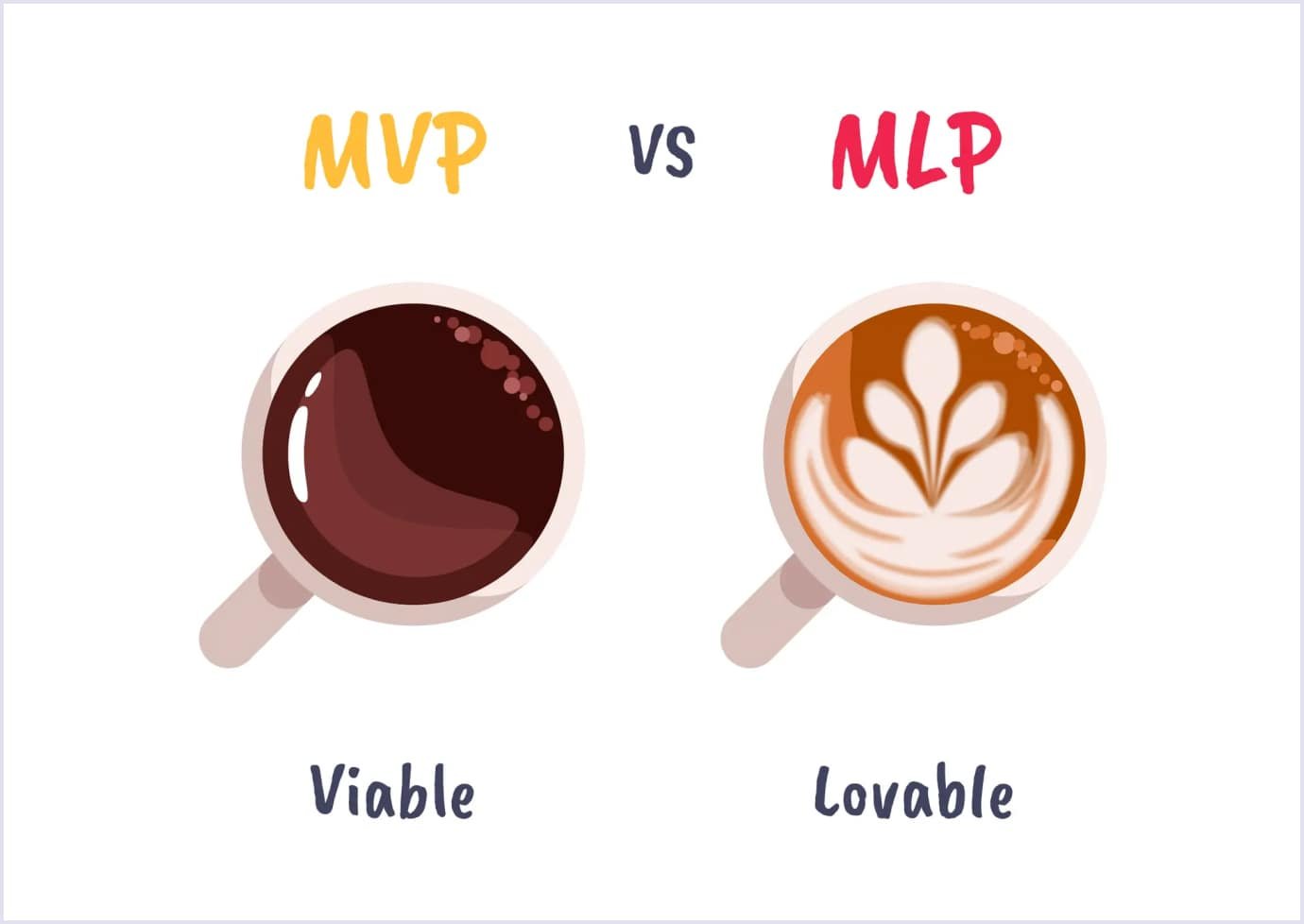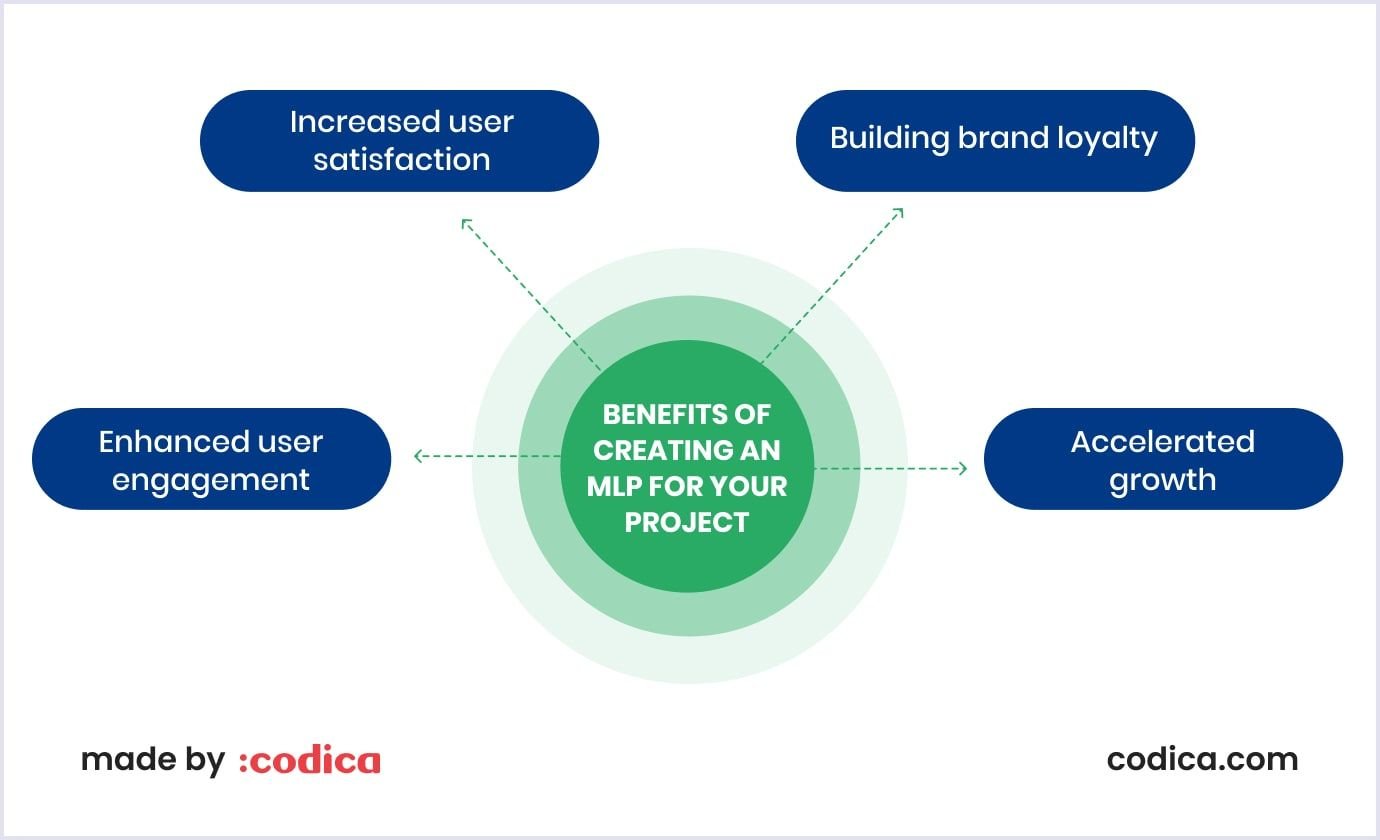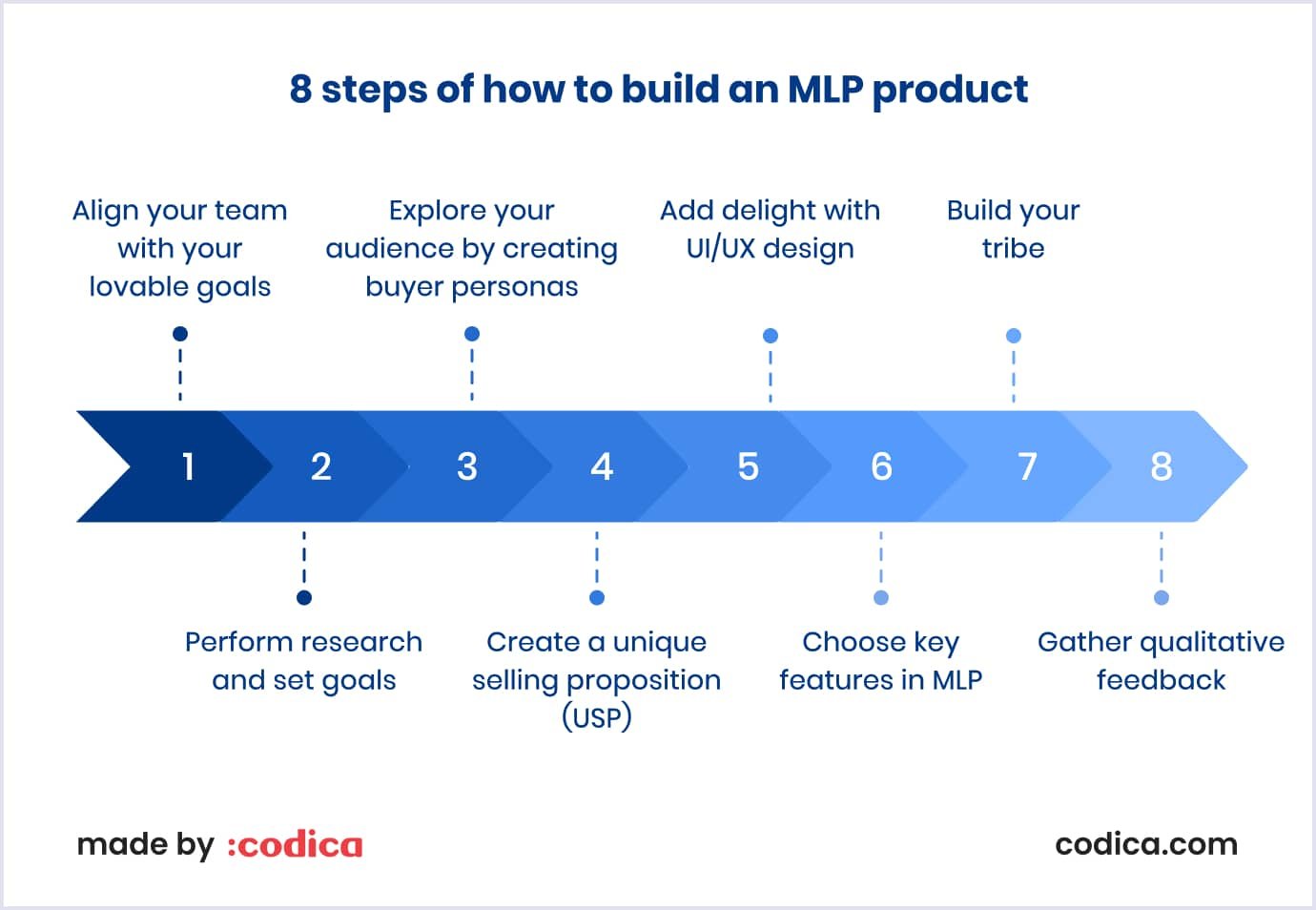Nowadays, software development doesn’t end when you build an MVP. The market is very diverse, offering numerous ways to grow your startup beyond MVP. Thus, there are several products you can build after releasing a minimum viable product.
In this piece, we will overview the natural successors of a minimum viable product (MVP), namely minimum marketable product (MMP) and minimum lovable product (MLP). Furthermore, we will dive into the development steps, outline their benefits, and see how they resonate with each other.
What comes after MVP?
As mentioned earlier, MVP is not a finish in software development. So, what comes next? Let’s approach the answer logically.
MVP gets released with core functionality only, often lacking in design, integrations, and non-essential features. It conveys the idea of the product, attracts early users, and gathers feedback. So, what would be the next logical step after you have gathered feedback and created an early user base?
Right, MMP. This one, in fact, is MVP’s successor. MMP stands for a minimum marketable product, and its mission is quite self-explanatory, which we’ll dive in later on. After the MMP has fulfilled its purpose, the next logical step would be creating a minimum lovable product or MLP.
Now, let’s take a look at both in more detail.

Minimum marketable product
Built on the foundation of MVP, the minimum marketable product bears everything provided by its predecessor but also adds several new aspects. Unlike MVP, it doesn’t focus on viability exclusively. So, what is minimum marketable product, and what differentiates it from others?
Instead, it comprises the viability and the marketability of the product. Hence, it includes enough features to attract early adopters and generate interest from potential customers. In other words, it aims to ‘sell’ the product to people. Another important consideration is how to make it successful.
What is a successful minimum marketable product?
Success for an MMP isn’t solely measured by basic metrics like revenue or retention rates. Instead, it’s gauged by the ability to validate assumptions, gather feedback, and iterate swiftly.
Success metrics for an MMP vary depending on the nature of the product and its target market. However, there are several universal indicators you should pay attention to.
- User engagement. Metrics such as the number of active users, retention rates, and usage patterns indicate the level of engagement with the MMP and are crucial in measuring the success of the campaign.
- Feedback quality. The quantity and quality of feedback gathered from early adopters reflect their level of satisfaction and the product’s alignment with their needs.
- Conversion rates. Tracking conversions from free trials or early access to paid subscriptions provides insights into the product’s monetization potential.
- Iteration speed. The time taken to implement user feedback and iterate on the product is a crucial metric for assessing agility and responsiveness.
In essence, the success of an MMP lies in its ability to navigate uncertainty, learn quickly, and adapt iteratively in pursuit of a compelling value proposition.
Benefits of creating a minimum marketable product for your project
Creating a minimum marketable product offers a multitude of benefits. Long-term success-wise, they are extremely helpful. Thus, let’s zoom in on them and see what creating an MMP can provide.

- Validate market demand
Following the results of MVP, a minimum marketable product can bring additional insights into the market demand for your product concept. It can reveal more about the niche you entered with MVP, as well as analyze the feedback from users and the community.
- Accelerate time to market
The iterative nature of MMP development enables you to prioritize essential features and expedite the product launch process. Rather than waiting to build a fully-fledged solution, you can get a functional version into the hands of users quickly, gaining a competitive edge and seizing market opportunities sooner.
- Enhance user engagement
As we learned from MVP, early adopters play a crucial role in shaping the trajectory of your product. Hence, involving them in the MMP phase shows your progress on the project and allows them to see how you accounted for feedback in the newer version.
- Facilitate iterative improvement
Agile in MVP development is a well-established practice. Being a successor to an MVP, a minimum marketable product contributes to this approach and serves as a launchpad for continuous iteration and refinement.
Minimum lovable product
This iteration is what comes after minimum marketable product. It prioritizes creating a version of the product that users don’t just find useful or viable but genuinely love and are enthusiastic about. It goes beyond the concept of an MVP or an MMP we discussed previously. This one focuses on delivering a superior user experience when using the product from the very beginning.

An MLP typically includes features and aspects of the product that resonate deeply with users, solve their problems in an innovative or delightful way, and evoke positive emotions, leading to strong user engagement, loyalty, and word-of-mouth promotion.
Creating an MLP requires an understanding of aspects beyond MVP’s and MMP’s jurisdiction. So, let’s define them.
Understanding the basics of a minimum lovable product (MLP)
Several key elements distinguish an MLP from other product development approaches:
User-centric design
Not only MLP is built around the needs of your target audience, but it also incorporates deep empathy and understanding of user personas to deliver experiences that resonate on an emotional level.
Delightful user experience
Every interaction with an MLP is designed to surprise and delight users. This version of the product should include intuitive interfaces, animations, etc. Every detail should evoke positive emotions and make the experience memorable.
Compelling brand story
Storytelling is a solid part of making the product lovable. Such stories often tell more about the product’s purpose, values, and mission. In turn, it can create an emotional connection and resonate with users.
Focus on UI/UX design
Visuals are crucial for provoking emotional responses and evoking thoughts. To do so, minimum lovable product, unlike its predecessors, prioritizes design, typography, and color schemes to create a visually stunning experience.
Benefits of creating an MLP for your project
Now that we have covered the essentials, let’s switch to the main benefits of a minimum viable product. Fortunately, there are many of them.

Enhanced user engagement
Although this statement was already mentioned, it is still one of the biggest advantages MLP provides for businesses. Simply put, an MLP goes beyond mere functionality. In addition to being a robust product on its own, it also taps into users’ emotions. This way, it can foster deep engagement and encourage repeat usage.
Increased user satisfaction
When users feel a genuine affection for your product, they’re more likely to overlook its shortcomings and remain loyal over the long term. Depending on the features you add, people may form a community around your product which is exactly what you need.
Building brand loyalty
As mentioned earlier, MLP embodies the brand’s values, philosophy, and further growth way. By creating a product that users love, you can strengthen brand loyalty and foster a community of passionate advocates.
Accelerated growth
Once you capture users’ attention to the product, they’re more likely to spread the word about it and evangelize on your behalf. This scenario can lead to exponential growth, enabling you to scale your business more rapidly and cost-effectively.
8 steps of how to build an MLP product
As with any software product, creating a minimum lovable product requires a strategy and a carefully thought-out sequence of work. Hence, here are eight essential steps to guide you through the process of creating an MLP.

Align your team with your lovable goals
Before diving into product development, it’s crucial to align your team around the shared goal of creating a product that users will love. In this planning, not only you will need to establish a development team but also outline clear objectives, values, and priorities to ensure everyone is on the same level and knows how to deliver.
Perform research and set goals
Any kind of research, be it about the market or users, is conducted during product discovery we will discuss later on. Speaking of raw research and goal definition, start with a thorough market analysis. Observe and analyze the performance of previous versions of your product (MVP and MMP).
This way, you will be able to see whether any trends have changed, spot new competitors, and update your information about end-user needs. Then, based on your findings, set specific, measurable goals for your MLP, such as user engagement metrics, customer satisfaction scores, or conversion rates.
Explore your audience by creating buyer personas
Develop detailed buyer personas to gain insights into your target audience’s demographics, preferences, pain points, and aspirations. This deep understanding will inform your product strategy and ensure that your MLP resonates with the right users on a personal level.
Create a unique selling proposition (USP)
This feature helps you identify what makes your product unique. Then, you can use obtained knowledge to amplify the USP, and make your product to be one-of-a-kind. In other words, your USP should highlight the key benefits and emotional appeal of your MLP.
Add delight with UI/UX design
It’s the UI/UX design that makes users fall in love with your product. Thus, do not hesitate to invest in visually appealing UI/UX design services. It will help you amplify the user experience and evoke positive emotions. Unlike in MVP, in a minimum lovable product, you should pay specific attention to aesthetics, usability, and interactivity. They form moments of delight that leave a lasting impression on users.
Read also: Minimum Viable Product Design: How to Build a Successful MVP
Choose key features in MLP
Select a curated set of features that align with your MLP’s core value proposition and resonate with your target audience. Prioritize functionality that delivers immediate value and enhances the overall user experience while keeping the product simple and focused.
When doing so, keep in mind that MLP is still not a full-scale project, and it may change in the future. Based on the existing functionality you implemented with MVP, gradually add new features to reach the goals for your MLP you set during product discovery.
Build your tribe
Although it could be challenging to do with MVP, a minimum lovable product tends to tackle this task much easier. Thanks to thoughtful design and functionality choices, you can cultivate a community of early adopters more easily.
However, always stay in contact with your users. Engage with them through social media, forums, and events to foster a sense of belonging and loyalty, turning them into ambassadors for your MLP.
Gather qualitative feedback
Following the previous step, continuously gather qualitative feedback from users throughout the development process to iterate and refine your MLP. Encourage open communication, listen attentively to user insights, and remain responsive to their needs and desires.
In the aftermath, these steps can easily change to adapt to your scenario. Moreover, depending on whether you start your product with MLP or it had previous iterations like MVP, you may have different objectives and choose a different way to tackle them.

Key properties of MLP vs MVP vs MMP
To sum up the comparison and outline all you should know about minimum viable product vs minimum marketable product vs minimum lovable product, let’s compose a table.
| Property | Minimum lovable product (MLP) | Minimum viable product (MVP) | Minimum marketable product (MMP) |
| Focus | Delightful user experience, emotional resonance | Core functionality, basic viability | Marketable features, customer value |
| Objective | Elicits genuine affection and loyalty from users | Validates assumptions, gathers feedback | Releases to market, establishes presence |
| User engagement | High engagement, emotional connection | Moderate engagement, functional utility | Growing engagement, value recognition |
| Development approach | User-centric design, iterative refinement | Lean startup methodology, rapid iteration | Iterative development, market validation |
| Feature selection | Features that delight and surprise users | Essential features for viability | Marketable features, early adopter appeal |
| Design | Emphasis on visual appeal, delightful UX | Functional design, usability | Functional design, market readiness |
| Market entry timing | May require longer development time | Rapid development, early market entry | Balanced development time, market readiness |
| Risk mitigation | Focuses on user satisfaction and loyalty | Addresses technical and market risks | Addresses market viability and scalability |
| Customer feedback | Emphasizes qualitative feedback | Emphasizes user validation, iteration | Emphasizes market validation, iteration |
| Market differentiation | Differentiates through emotional resonance | Differentiates through innovation | Differentiates through value proposition |
| Long-term sustainability | Fosters brand loyalty, and sustained growth | Validates product-market fit, and scalability | Establishes market presence, and growth path |
How Codica builds products that users enjoy
With years of experience behind our back, the Codica team knows how to develop not only lovable, but genuinely good products ranging in niche, functionality, and complexity. In this regard, our product discovery service is irreplaceable.
It encompasses everything from idea glimpses to in-depth research of your future product. In close cooperation with founders, we conduct research, spot potential rivals, compose extensive project documentation, and provide time and cost estimates for developing a full-scale project. In short, this process allows us to lay a foundation for any project and create a solid basis before we even start the design and development processes.
After all, here’s a quick video explaining everything you should know about the product discovery we conduct.
Furthermore, we are no strangers to minimum viable product development and its following iterations. With our MVP development services, we know how to build scalable, performant, and effective products that can effectively gather feedback and present your product on the market early.
Additionally, we know how to build software products in various niches, including automotive, insurance, ecommerce, travel, and more. Furthermore, we work with various clients, such as startups, and mid-sized and enterprise-level businesses. In the aftermath, thanks to the thoughtful approach, MVP development services allow us to minimize development costs, quickly launch your product, and test your idea swiftly without developing a full-scale product.
Final words
In summary, note that there is no single right path to develop a product. MVP and its iterations in the form of MLP and MMP are just one of many approaches you can follow. However, at Codica, we adhere to it as it is robust enough to provide us flexibility, room for iterations, and continuous improvement.
It’s important to understand that approaches change, and in custom software development, you will need to be open to those changes along with the benefits they can bring. Hence, feel free to check our blog to stay updated on the latest technologies, approaches, and topics in software development. Lastly, do not hesitate to contact us.
